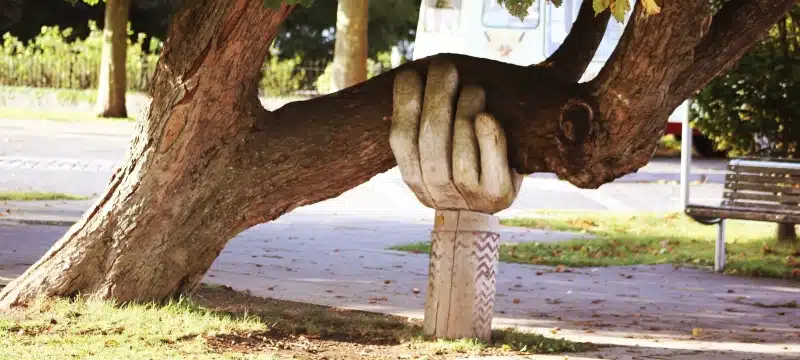Modern Slavery?
by Gary Corwin
For almost all of us, at the margins of our consciousness is an awareness of something called human trafficking. It’s there, and we know that it’s real, but we assume that it’s a tiny, tragic blip on the scope of human experience.
Speak up for those who cannot speak for themselves, for the rights of all who are destitute. Speak up and judge fairly; defend the rights of the poor and needy. —Prov. 31:8-9
The Spirit of the Lord is on me, because he has anointed me to proclaim good news to the poor. He has sent me to proclaim freedom for the prisoners and recovery of sight for the blind, to set the oppressed free… —Luke 4:18
For almost all of us, at the margins of our consciousness is an awareness of something called human trafficking. It’s there, and we know that it’s real, but we assume that it’s a tiny, tragic blip on the scope of human experience—perhaps a subtitle in the story of kidnapping more generally. I was recently part of a study group on human trafficking that made clear the shortcomings of such assumptions.
This week as I write, the subject has been brought home in a dramatic way for many Americans with the rescue in a quiet U.S. neighborhood of three young women who had been held and sexually abused for over a decade. In fact, at least 100,000 to 300,000 youth are at risk for commercial sexual exploitation annually in the U.S.
But sexual slavery is not the only face of human trafficking. It may also be for cheap labor, for smuggling, or for military purposes (including child soldiers), just to name a few major categories. The common denominator in all these manifestations is that force, fraud, or coercion in one form or another is used in order to ensure the compliance of those being trafficked.
And although “trafficking” may conjure up an image of cross-border smuggling of human beings, the term actually has two very specific technical and legal definitions, one for sex trafficking and one for labor trafficking (which also applies to other kinds of services). The scope in both definitions includes recruitment, harboring, transportation, and provision of persons for the specific activities (definitions from the Trafficking Victims Protection Act, and may be easily accessed through the NHTRC; see contact information later in this article).
When force is employed the means may include kidnapping, confinement, physical assault, sexual assault and rape, or other violence. Fraud often includes fraudulent employment offers or contracts, false promises about work and living conditions, false promises of education, and withholding wages. The means of coercion often include threats of deportation or arrest; blackmail; threats to life, personal safety, family members or other victims; debt bondage; withholding legal documents; and psychological manipulation (NHTRC).
Why is this important to the readers of EMQ, which after all is a mission journal and not a law enforcement one? The primary reason is that this horrendous practice is everywhere, in every context where the Lord’s servants engage in the task of mission, and in its wake are powerless casualties for whom Christ died, trapped in slavery. Yet while the victims of this atrocious practice are largely powerless, we are not, and the Lord would want us to do everything in our power to free them (“…the least of these …”). If we are concerned that those among whom we work have clean water and adequate medical care, we ought also to be concerned that these cruelly-treated slaves in our midst gain freedom.
What can we do? First, minister to the victims and, when possible, provide information about the perpetrators to authorities. But on the way to either of these things, it is necessary to know where trafficking tends to occur, the indicators that identify it, and where we can go to find help. Of the three, the where is probably the most context-specific, although some venues are pretty universal (e.g., street prostitution, pornography, escort services, online sex, and labor contexts like agriculture, construction, domestic work, peddling/begging, drug trafficking, and bonded labor).
Indicators of sex trafficking to look for include being under 18 and providing commercial sex, not being free to leave/come and go as he or she wishes, being unable to pay off a large debt, having been recruited through false promises, and signs of physical and/or sexual abuse. In the labor sphere these indicators include being confined to the workplace or employer-provided housing, being unable to pay off a large debt, not being in control of one’s own ID documents, being recruited through false promises, and being unpaid, paid very little, or paid only in tips.
Finding help will also vary greatly with the contexts. For immediate help or as a link to other global resources, contact the National Human Resource Center (NHTRC): 1.800.375.7888, nhtrc@polarisproject.org or visit www.traffickingresourcecenter.org.
Whatever the mission community can do to help ameliorate this scourge will be the result of many small and local victories accomplished over many years. But big breakthroughs are also possible. Both are part of the church’s history in the modern period. William Wilberforce spent decades in Parliament, and finally won the day to end British slavery. The Quakers used kitchen-table diplomacy to build a movement against slavery in the USA in the years before the Civil War. It can happen again. Lord, give us your eyes to see and your hands to help.
TRAGIC NUMBERS
The numbers below give a sampling of the scope of this issue today. However, behind each of these numbers is also a face, millions of faces, in desperate need of kindness, compassion, and the knowledge that they are loved and valued.
• After the drug trade, trafficking of humans is tied with arms as the second largest criminal industry in the world and is the fastest growing. It is a $35 billion business.
• Between 13 and 27 million people from 127 nations are believed to be victims of trafficking globally.
• Of the 600,000-800,000 people trafficked across international borders annually, 80% of victims are females and 50% minors.
• More than 2 million children are sexually exploited in the slave trade each year.
• The average girl sold into a brothel is 14 years old.
• In Thailand, 200,000 girls and women are exploited each year. 20,000-30,000 of these are children.
• In Kolkata alone, there are more than 60,000 brothel-based women and girls in prostitution.
• Costa Rica has more than 300 brothels in San Jose alone. Sex tourism in this country is numbered at 5,000 tourists.
• 80% of girls leaving orphanages in Eastern Europe are sold to or tricked by traffickers.
….
Gary Corwin is associate editor of EMQ and staff missiologist with the international office of SIM.
EMQ, Vol. 49, No. 4, pp. 134-135. Copyright © 2013 Billy Graham Center. All rights reserved. Not to be reproduced or copied in any form without written permission from EMIS.


